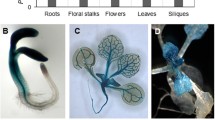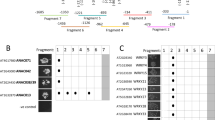Abstract
Plants respond to pathogen attack by induction of various defence responses, including the biosynthesis of protective secondary metabolites. In Catharanthus roseus, the elicitor-induced expression of the terpenoid indole alkaloid biosynthetic gene Strictosidine synthase (Str) is mediated via the plant stress hormone jasmonate. In the promoters of several defence-related genes, cis-acting elements have been identified that are important for transcriptional regulation upon stress signals. Here we show that an upstream region in the Str promoter confers responsiveness to partially purified yeast elicitor and jasmonate. Yeast one-hybrid screening with this element as a bait identified a MYB-like protein, which shows high homology to parsley box P-binding factor-1 (PcBPF-1). In vitro analyses showed that the Str promoter fragment contained a novel binding site for BPF-1-like proteins with higher binding affinity than the previously described box P. CrBPF-1 mRNA accumulated rapidly in elicitor-treated C. roseus suspension cells, whereas no induction was observed with jasmonate. Inhibitor studies indicated that CrBPF-1 plays a role in an elicitor-responsive but jasmonate-independent signal transduction pathway, acting downstream of protein phosphorylation and calcium influx.
Similar content being viewed by others
References
Creelman, R.A. and Mullet, J.E. 1997. Biosynthesis and action of jasmonates in plants. Annu. Rev. Plant Physiol. Plant Mol. Biol. 48: 355–381.
da Costa e Silva, O., Klein, L., Schmelzer, E., Trezzini, G.F. and Hahlbrock, K. 1993. BPF-1, a pathogen-induced DNA-binding protein involved in the plant defense response. Plant J. 4: 125–135.
de Pater, S., Pham, K., Memelink, J. and Kijne, J.W. 1997. RAP-1 is an Arabidopsis MYC-like R protein homologue, that binds to G-box sequence motifs. Plant Mol. Biol. 34: 169–174.
Dröge-Laser, W., Kaiser, A., Lindsay, W.P., Halkier, B.A., Loake, G.J., Doerner, P., Dixon, R.A. and Lamb, C. 1997. Rapid stimulation of a soybean protein-serine kinase that phosphorylates a novel bZIP DNA-binding protein, G/HBF-1, during the induction of early transcription-dependent defenses. EMBO J. 16: 726–738.
Ellard-Ivey, M. and Douglas, C.J. 1996. Role of jasmonates in the elicitor-and wound-inducible expression of defense genes in parsley and transgenic tobacco. Plant Physiol. 112: 183–192.
Feldbrügge, M., Sprenger, M., Hahlbrock, K. and Weisshaar, B. 1997. PcMYB1, a novel plant protein containing a DNAbinding domain with one MYB repeat, interacts in vivo with a light-regulatory promoter unit. Plant J. 11: 1079–1093.
Goff, S.A., Cone, K.C. and Chandler, V.L. 1992. Functional analysis of the transcriptional activator encoded by the maize B gene: evidence for a direct functional interaction between two classes of regulatory proteins. Genes Dev. 6: 864–875.
Green, P.J., Kay, S.A., Lam, E. and Chua, N.-H. 1991. In vitro DNA footprinting. In: S.B. Gelvin, R.A. Schilperoort and D.P.S. Verma (Eds.) Plant Molecular Biology Manual, Kluwer Academic Publishers, Dordrecht, Netherlands, pp. B11/1–22.
Grueneberg, D.A., Natesan, S., Alexandre, C. and Gilman, M.Z. 1992. Human and Drosophila homeodomain proteins that enhance the DNA-binding activity of serum response factor. Science 257: 1089–1095.
Gundlach, H., Müller, M.J., Kutchan, T.M. and Zenk, M.H. 1992. Jasmonic acid is a signal transducer in elicitor-induced plant cell cultures. Proc. Natl. Acad. Sci. USA 89: 2389–2393.
Lois, R., Dietrich, A., Hahlbrock, K. and Schulz, W. 1989. A phenylalanine ammonia-lyase gene from parsley: structure, regulation and identification of elicitor and light responsive cis-acting elements. EMBO J. 8: 1641–1648.
Lugert, T. and Werr, W. 1994. A novel DNA-binding domain in the Shrunken initiator-binding protein (IBP1). Plant Mol. Biol. 25: 493–506.
Martin, C. and Paz-Ares, J. 1997. MYB transcription factors in plants. Trends Genet. 13: 67–73.
Maxam, A.M. and Gilbert, W. 1980. Sequencing end-labelled DNA with base-specific chemical cleavages. Meth. Enzymol. 65: 499–560.
Meijer, A.H., Ouwerkerk, P.B.F. and Hoge, J.H.C. 1998. Vectors for transcription factor cloning and target site identification by means of genetic selection in yeast. Yeast 14: 1407–1416.
Menke, F.L.H. 1999. Elicitor signal transduction in Catharanthus roseus leading to terpenoid indole alkaloid biosynthetic gene expression. Ph. D. thesis, Leiden University, Leiden, Netherlands.
Menke, F.L.H., Parchmann, S., Mueller, M.J., Kijne, J.W. and Memelink, J. 1999a. Involvement of the octadecanoid pathway and protein phosphorylation in fungal elicitor-induced expression of terpenoid indole alkaloid biosynthetic genes in Caharanthus roseus. Plant Physiol. 119: 1289–1296.
Menke, F.L.H., Champion, A., Kijne, J.W. and Memelink, J. 1999b. A novel jasmonate-and elicitor-responsive element in the periwinkle secondary metabolite biosynthetic gene Str interacts with a jasmonate-and elicitor-inducible AP2-domain transcription factor, ORCA2. EMBO J. 18: 4455–4463.
Menkens, A.E., Schindler, U. and Cashmore, A.R. 1995. The Gbox: a ubiquitous regulatory DNA element in plants bound by the GBF family of bZIP proteins. Trends Biochem. Sci. 20: 506–510.
Nojiri, H., Sugimori, M., Yamane, H., Nishimura, Y., Yamada, A., Shibuya, N., Kodama, O., Murofushi, N. and Omori, T. 1996. Involvement of jasmonic acid in elicitor-induced phytoalexin production in suspension-cultured rice cells. Plant Physiol. 110: 387–392.
Neuteboom, S.T.C., Stoffels, A., Hulleman, E., Memelink, J., Schilperoort, R.A. and Hoge, J.H.C. 1993. Interaction between the tobacco DNA-binding acitvity CBF and the cyt-1 promoter element of the Agrobacterium tumefaciens T-DNA gene TCYT correlates with cyt-1 directed gene expression in multiple tobacco tissue types. Plant J. 4: 525–534.
Ouwerkerk, P.B.F. and Memelink, J. 1997. A simple method for directional multimerization of DNA sequences. Technical Tips Online (http://www.elsevier.com/locate/tto) T01051 (Trends Genet. 13: 207).
Ouwerkerk, P.B.F., Trimborn, T.O., Hilliou, F. and Memelink, J. 1999. Nuclear factors GT-1 and 3AF1 interact with multiple sequences within the promoter of the Tdc gene from Madagascar periwinkle: GT-1 is involved in UV light-induced expression. Mol. Gen. Genet. 261: 610–622.
Pasquali, G., Erven, A.S.W., Ouwerkerk, P.B.F., Menke, F.L.H. and Memelink, J. 1999. The promoter of the strictosidine synthase gene from periwinkle confers elicitor-inducible expression in transgenic tobacco and binds nuclear factors GT-1 and GBF. Plant Mol. Biol. 39: 1299–1310.
Pasquali, G., Goddijn, O.J.M., de Waal, A., Verpoorte, R., Schilperoort, R.A., Hoge, J.H.C. and Memelink, J. 1992. Coordinated regulation of two indole alkaloid biosynthetic genes from Catharanthus roseus by auxin and elicitors. Plant Mol Biol 18: 1121–1131.
Pasquali, G., Ouwerkerk, P.B.F. and Memelink, J. 1994. Versatile transformation vectors to assay the promoter activity of DNA elements in plants. Gene 149: 373–374.
Riechmann, J.L. and Meyerowitz, E.M. 1998. The AP2/EREBP family of plant transcription factors. Biol. Chem. 379: 633–646. 685
Reymond, P. and Farmer, E.E. 1998. Jasmonate and salicylate as global signals for defense gene expression. Curr. Opin. Plant Biol. 1: 404–411.
Rushton, P.J. and Somssich, I.E. 1998. Transcriptional control of plant genes responsive to pathogens. Curr. Opin. Plant Biol. 1: 311–315.
Titarenko, E., Rojo, E., Leon, J. and Sánchez-Serrano, J.J. 1997. Jasmonic acid-dependent and-independent signaling pathways control wound-induced gene activation in Arabidopsis thaliana.</del>Plant Physiol. 115: 817–826.
van der Fits, L. and Memelink, J. 1997. Comparison of the activities of CaMV 35S and FMV 34S promoter derivatives in Catharanthus roseus cells transiently and stably transformed by particle bombardment. Plant Mol. Biol. 33: 943–946.
Author information
Authors and Affiliations
Rights and permissions
About this article
Cite this article
van der Fits, L., Zhang, H., Menke, F.L. et al. A Catharanthus roseus BPF-1 homologue interacts with an elicitor-responsive region of the secondary metabolite biosynthetic gene Str and is induced by elicitor via a JA-independent signal transduction pathway. Plant Mol Biol 44, 675–685 (2000). https://doi.org/10.1023/A:1026526522555
Issue Date:
DOI: https://doi.org/10.1023/A:1026526522555




